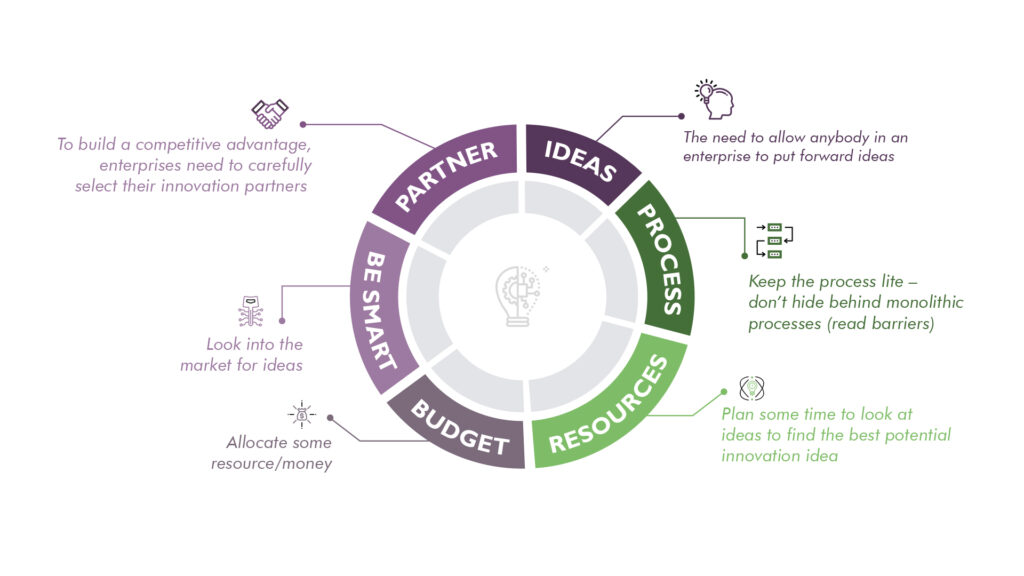4 Key Principles For CIO While Selecting An Innovation Partner
Introduction:
In today’s complex and fast changing world, the role of the CIO is not an easy one. Balancing the demands of the commercial business, key IT sponsored programmes, compliance (The California Online Privacy Protection Act, The Computer Security Act of 1997 and GDPR to name a few) and let us not even go into the territory of Digital and Agile working practices! It’s not surprising that IT innovation usually ends up low down the priority list. Add this to the challenge of securing funding for efforts that may not have clear paybacks then the result is Technology Innovation is often ignored completely! Is this acceptable?
Technology Innovation – Ownership
Well the short answer would be everyone and anyone in an enterprise could and should have a role. But where should ownership reside? I set it hard to argue that there is no better place than that of the office of the CIO. The question CIO’s need to ask is ‘am I comfortable’ with that responsibility and maybe ‘am I comfortable’ with it outside IT? If you come to the conclusion that you should own it then you need to take actions to make this happen.
Plan
In order to really gain momentum, there are a few key principles that need to be considered:

- The need to allow anybody in an enterprise to put forward ideas – Technology ideas are no longer the exclusive domain of IT. Accept and embrace it. The enterprise innovation groups are bombarded with unlimited ideas coming from various internal teams. The issue is in identifying the right idea and the required time to nurture these ideas.
- Keep the process light – don’t hide behind monolithic processes (read barriers) – The CIO’s we speak to often say that they mostly qualify ideas based on factors such as exertion, money, production, and achievement. This process is high cost and time-consuming, resulting in ideas being scrapped even before they are properly considered. The key is to identify ideas with minimum effort and filter the ones with maximum potential benefit. This is easier said than done using monolithic processes in innovation.
- Resources – plan some time to look at ideas to find the best potential innovation idea. While considering an idea CIOs are forced to consider the following factors such as the effort, capital and output required, to turn these ideas to functional products.
- Budget – allocate some resource/money – In today’s digital era, CIO’s often shy away from adopting a ‘silver bullet’ approach to technology innovation. CIO’s should think of ways of starting small and gain some traction.
- Be smart – look into the market for ideas – for example have you looked at RPA and how you could use it to improve your business processes (including IT) or extend a legacy system or two. What are businesses in other industries doing? Could you ‘migrate’ the model to your business?
- Partner – To build a competitive advantage, enterprises need to carefully select their innovation partners. Enterprises should look to select an innovation partner who is able to bring a global delivery model leveraging onsite and offshore advantages to the party.
Innovation Partner
For those ideas that require software to be built the golden rule is not to spend any more than you must in order to prove or disprove the idea. Look for a partner who does not treat innovation projects the same way as mainstream IT projects – business cases/project and expects the same guarantees on the investment return. Enterprises should look for innovation partners who give preference to ROI-backed innovation or in other terms sustainable innovation. An equally cost-effective method for sustainable innovation is adoption of Frugal Innovation methodology for technology innovation by enterprises.
Ignitho Technologies, headquartered in the USA, and with its offices in New York, USA & London, UK, and its innovation labs & development centres in Richmond, USA, Brighton, UK and Kochi, India, specialises in Digital Applications – The ability to start small and deliver quick outcomes which are inherently scalable, for the web, mobile and cloud and Innovation Pods – The ability to build focused agile pods with cross-functional teams delivering faster prototypes and digital solutions. The secret of success for Ignitho lies in their Frugal Innovation methodology – “the ability to do more with less” – developed in collaboration with a world-renowned thought leader from the University of Cambridge.
With its Frugal Technology Innovation methodology, Ignitho works with enterprises to identify potential ideas and using the geographically spread innovation labs to build MVPs. This allows enterprises to take up a step-by-step approach to technology innovation instead of going for the big bang approach which could, in turn, hurt their IT budget.
In summary, the CIO’s should invest the time and take the lead on Innovation and should not be afraid to do so. There are great tools and partners who can help CIO’s succeed on the journey. You may not find a ‘silver bullet’ idea but if you start the journey with a partner like Ignitho, you will find things that can improve your business and that can’t be a bad thing.
